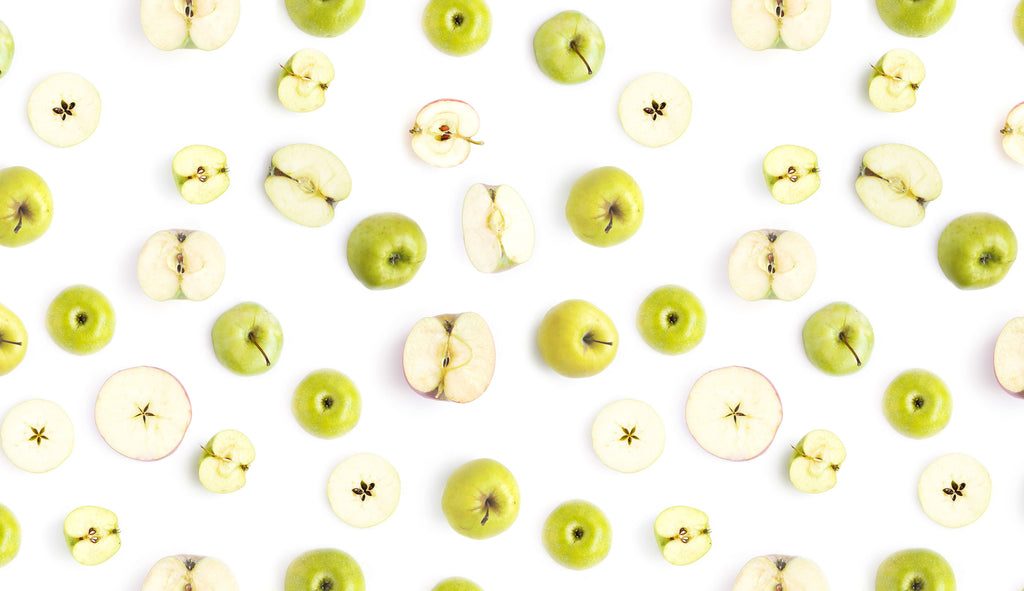How these fruit-derived natural acids can boost your anti-aging products for brighter, more youthful looking skin
Posted on October 23, 2024 Written by: 100% PURE®
As winter drags on, it can plague us with a variety of skin woes – specifically dull, lackluster complexions. Skin dryness, the harsh winter elements, and an accumulation of dead skin cells can all combine into the perfect storm of tired, unhealthy-looking skin.
Enter Alpha Hydroxy Acids! These natural acids are derived from fruits, and they can have a serious impact on winter skin. These acids help to exfoliate your skin at the cellular level, helping it to get rid of dead skin cells that can clog your pores and dull your complexion. In this post, we’ll discuss the benefits of alpha hydroxy acid for different skin types, and how to use these beneficial ingredients for your skin.
What Are Alpha Hydroxy Acids?
Alpha hydroxy acids (AHAs for short) are chemical compounds that are found naturally in many common foods, and especially in fruits. Green apple, berries, and citrus fruits are all natural sources of alpha hydroxy acids. These acids are commonly included in skin care product formulas in order to help cleanse and exfoliate the skin. Acne products, exfoliating products, and anti aging products often contain alpha hydroxy acids.
Alpha hydroxy acids are gentler on your skin than conventional face peels. They’re so gentle that they’re generally considered suitable for use on sensitive skin. Lactic acid in particular has been shown to benefit sensitive skin types.
Importantly, alpha hydroxy acids exfoliate your skin at the cellular level, weakening the bonds that keep dead skin cells stuck to the surface of your skin. You may not literally see dead skin being sloughed away when you use alpha hydroxy acids, but they’re definitely doing the job.
How to Use Alpha Hydroxy Acids
AHA benefits for dull skin and uneven complexion
Skin dullness is often caused by a combination of poor circulation and dead skin cell buildup. Alpha hydroxy acids can help to tackle both of these problems in one go, promoting the flow of collagen and blood to your skin while helping it to shed those pesky, dead cells. Alpha hydroxy acids can also benefit dull, tired complexions by promoting healthy cell regeneration.
AHAs for acne-prone skin
Acne occurs when the follicles in your skin get plugged up with excess sebum and dead skin cells. The exfoliating powers of alpha hydroxy acids can benefit acneic skin by keeping pores clear of dead skin cells, and therefore reducing the severity of breakouts. Some alpha hydroxy acids also have antimicrobial properties that can help to combat acne-causing bacteria in your skin tissue. And not only do alpha hydroxy acids help to fight existing breakouts and prevent future ones; they can also help to diminish the appearance of scars from previous acne breakouts.
Alpha hydroxy acids for sun-damaged skin
Alpha hydroxy acids, particularly lactic acid, can also yield great results for photo-damaged skin. If you’re noticing age spots or discoloration on your skin that may be from sun exposure, a product with alpha hydroxy acids may help to promote healthy cell turnover, resulting in a more even complexion with ewer dark spots. These products can be used on your face, neck, and chest to combat the signs of skin damage caused by harsh UV rays.
Alpha hydroxy acids are generally considered safe for use on all skin types, but it’s important to note that your skin may be more photosensitive than usual after exposure to these ingredients. If you’ve just used a product that contains alpha hydroxy acid, we recommend that you take extra care to apply a layer of sunscreen before leaving home for the day. There’s no evidence to link alpha hydroxy acids with an increased risk of skin cancer, but it’s still important to protect your skin, especially when it might be unusually sensitive!
Alpha hydroxy acids for aging skin
Alpha hydroxy acids benefit the skin at the cellular level by promoting collagen production, cellular regeneration, and healthy blood flow. They’ve been used as anti aging treatments for centuries, and it’s even rumored that Cleopatra used to bathe in sour milk (a common source of lactic acid). Alpha hydroxy acids can ease the appearance of fine lines, wrinkles, and dark spots, and can also promote skin elasticity and firmness. Meanwhile, they can brighten and even out your complexion, making them a plant-based powerhouse for mature skin.
6 Types of Alpha Hydroxy Acids
Glycolic Acid
Glycolic acid is derived from natural sources like pineapple and sugarcane. It penetrates deeply into the skin to promote healthy cell function and youthfulness.
Lactic Acid
Lactic acid can be derived from tomatoes or milk. Its exfoliating properties make it a powerful treatment for acne and keratosis pilaris; it may also help to firm and tone the skin. It’s also especially gentle , making it a good option for sensitive skin.
Mandelic Acid
Mandelic acid can be derived from almonds or cherries. It has exfoliating and antibacterial properties, making it an excellent ingredient in products for acne-prone skin.
Citric Acid
Citric acid is one of the most recognizable AHAs, since it’s often found in food. Much like its name suggests, it is derived from various citrus fruits. Similar to mandelic acid, it has antibacterial properties that can help to combat acne while exfoliating your skin.
Malic Acid
Malic acid is most commonly derived from apples. Not only is it a great exfoliant–it’s also especially rich in antioxidants, making it great anti aging ingredient in skincare products.
Tartaric Acid
Tartaric acid is most commonly derived from grapes. It has PH-balancing properties that can help to soothe and heal inflammation and over-processing.
Alpha Hydroxy Acids Vs. Beta Hydroxy Acids in Skin Care
While alpha hydroxy acids may be especially beneficial for photo-damaged and mature skin, there’s another class of hydroxy acids out there that can yield excellent results for oily skin. These are called beta hydroxy acids.
Like alpha hydroxy acids, beta hydroxy acids are derived from plant sources (particularly fruits). But while alpha hydroxy acids are water-soluble, beta hydroxy acids are oil-soluble,meaning they dissolve in oil. This makes them an effective product for use on oily skin. The most common beta hydroxy acid in skincare is salicylic acid, which is commonly derived from strawberries, and is often found as an ingredient in acne treatments.
100% PURE Products
When it comes to enhancing your skincare routine with the power of AHAs, we offer a range of effective products designed to boost your skin’s radiance and youthful appearance. These high-quality, fruit-derived formulas are crafted with natural ingredients that not only exfoliate but also nourish and rejuvenate your skin. Incorporating these products into your regimen can help you achieve brighter, healthier-looking skin while maximizing the benefits of AHAs.
Here are some standout 100% PURE products to consider adding to your skincare lineup:
Vitamin C Serum
This serum boosts collagen production, complements AHAs by brightening the complexion, and promotes cell regeneration for anti-aging benefits.
Multi-Vitamin + Antioxidants Potent PM Serum
Contains retinol, which pairs well with AHAs in nighttime routines to effectively reduce wrinkles and fine lines.
10% Fruit Acids Apple Enzyme Resurfacing Serum
This serum offers a gentle yet effective exfoliation, helping to brighten the skin and reduce texture.
7% Fruit Acids Apple Enzyme Exfoliating Cleanser
A cleansing product that utilizes fruit acids to exfoliate and cleanse the skin, making it an excellent addition to your skincare routine.
Looking for more natural skin care and makeup guides with anti-aging products and tips? Check out our guide to the best anti-aging under eye concealer, or a list of the top 9 anti-aging ingredients!
Frequently Asked Questions About AHA’s
Which AHA is best for sensitive skin types?
Lactic acid is often considered the best AHA for sensitive skin types due to its gentle exfoliating properties. Derived from milk, lactic acid helps to exfoliate without causing significant irritation, making it suitable for those with sensitive skin.
Can AHAs help with hyperpigmentation or dark spots?
Yes, AHAs can be effective in reducing hyperpigmentation and dark spots. They promote healthy cell turnover, which helps to fade discoloration over time. By exfoliating the surface layer of the skin, AHAs encourage the growth of new, evenly pigmented skin cells, leading to a brighter and more uniform complexion.
What precautions should be taken when using AHAs during the day?
When using AHAs during the day, it’s essential to apply sunscreen with high SPF, as these acids can increase your skin’s sensitivity to the sun. It’s also advisable to start with lower concentrations to assess your skin’s tolerance and avoid combining AHAs with other potent ingredients, such as retinoids or strong exfoliants, to minimize irritation.
Are alpha hydroxy acids safe to use for all skin types?
AHAs are generally safe for most skin types, but individuals with very sensitive or reactive skin may need to exercise caution. It’s recommended to perform a patch test before using a new product containing AHAs to start with lower concentrations to gauge your skin’s reaction. Those with certain conditions, such as rosacea, should consult a dermatologist before use.
How do glycolic acid and lactic acid differ in skincare benefits?
Glycolic acid, derived from sugarcane, has a smaller molecular size, allowing it to penetrate the skin more deeply and effectively exfoliate. It’s known for its ability to improve skin texture and reduce the appearance of fine lines. Lactic acid, on the other hand, is larger in molecular size and tends to be milder, making it a great option for sensitive skin. It provides exfoliation while also delivering hydration, making it suitable for promoting overall skin health and brightness.

